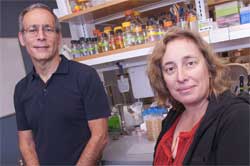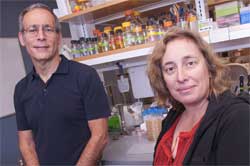 KINGSTON, R.I. – June 21, 2012 – One of the greatest challenges for the aquaculture industry is health management. A disease outbreak can spread quickly and kill every last fish. And because antibiotic use is restricted at fish farms, one of the best options for maintaining a healthy fish population is the use of vaccines.
KINGSTON, R.I. – June 21, 2012 – One of the greatest challenges for the aquaculture industry is health management. A disease outbreak can spread quickly and kill every last fish. And because antibiotic use is restricted at fish farms, one of the best options for maintaining a healthy fish population is the use of vaccines.
“DNA vaccines are a novel type of vaccine that have proven to be very effective at preventing disease, but only when delivered by injection into the muscle of the fish or by shooting them with gold particles using a gene gun,” explained Marta Gomez-Chiarri, professor of fisheries at the University of Rhode Island. “But vaccinating one fish at a time is very expensive.”
Gomez-Chiarri and fellow URI Professor David Nelson have developed a simple and inexpensive vaccine delivery system that involves the immersion of the fish in a vaccine bath. The URI scientists were awarded a patent for their discovery, and at a ceremony last month they received the Intellectual Property Award of Excellence from the URI Division of Research and Economic Development.
“You can treat a lot of fish very quickly by immersion,” said Gomez-Chiarri, a resident of Jamestown. “Initially, too little of the DNA vaccine was getting into the fish to be effective, perhaps because it was getting degraded in the water or in the gut of the fish. So we found a way of putting the vaccine inside bacteria that are good at getting into the fish and then bathing the fish in the bacterial solution.”
The key was getting the vaccine into the proper tissues so the fish’s immune system recognizes it and produces an appropriate immune response. But that also raised concerns.
“Fish pathogens are really good at getting into fish, but we have to have a way to attenuate their virulence so they can deliver the vaccine without causing disease,” she said. “That’s the fine balance.”
Gomez-Chiarri said there is still a lot of work to do before the method is commercialized. The delivery method was initially tested using a vaccine against a trout virus that is common in aquaculture facilities in the Pacific Northwest, and she hopes to test a refined version of the vaccine there again soon.
“You usually target diseases that have a big economic impact and affect a variety of different species,” said Gomez-Chiarri. “Many vaccine companies, for example, are trying to help the salmon industry in Chile, which is impacted by a flu-like virus that causes infectious salmon anemia.”
Applying for a patent can be a long and expensive process. It took almost 10 years for the U.S. Patent Office to award the patent to Gomez-Chiarri and Nelson for their vaccine delivery system.
“Our next step is to try using a few more kinds of bacteria to put the vaccine into, and then compare the delivery by injection with delivery by immersion,” she said. “Hopefully we’ll find a company that is interested in our work and willing to provide funding for us to continue to make it better.”
URI Department of Communications & Marketing photo by Michael Salerno Photography.

